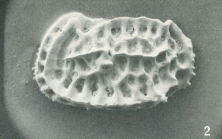
| Intro | | About | | Wiki | | Search traits | | Data explorer | | Literature | | Definitions | | Sources | | Webservices | | Statistics | | Feedback | | Editors | | Log in |
Ostracoda taxon detailsQuasibradleya prodictyonites Benson, 1972
794409 (urn:lsid:marinespecies.org:taxname:794409)
accepted
Species
Bradleya (Quasibradleya) prodictyonites Benson, 1972 · unaccepted
marine,
Benson, R.H. (1972). The <i>Bradleya</i> Problem, with descriptions of two new psychrospheric ostracode genera, <i>Agrenocythere</i> and <i>Poseidonamicus</i> (Ostracoda: Crustacea). <em>Smithsonian Contributions to Paleobiology.</em> (12), 1-138., available online at http://si-pddr.si.edu/jspui/handle/10088/1879 [details] Available for editors
Note "The specimens considered in the description...
From editor or global species database
Type locality "The specimens considered in the description of B. (Q.) prodictyonites were from Hornibrook's (1952) sample locality F5052 (Duntroonian; lower Oligocene) from near Chatton S.D., New Zealand. Sample supplied to me by Dr. Hornibrook in 1960." (Benson, 1972; 45) [details]
Distribution "Paleogene of New Zealand." (Benson, 1972; 45)
Distribution "Paleogene of New Zealand." (Benson, 1972; 45) [details]
Brandão, S. N.; Antonietto, L. S.; Pereira, J. S.; Pereira, S. G. G.; Sá, H. A. B.; Praxedes, R. A.; Sabater, L. M., Santos, S.G.; Karanovic, I. (2025). World Ostracoda Database. Quasibradleya prodictyonites Benson, 1972. Accessed at: https://www.marinespecies.org/ostracoda/aphia.php?p=taxdetails&id=794409 on 2025-05-21
Date action by
original description
Benson, R.H. (1972). The <i>Bradleya</i> Problem, with descriptions of two new psychrospheric ostracode genera, <i>Agrenocythere</i> and <i>Poseidonamicus</i> (Ostracoda: Crustacea). <em>Smithsonian Contributions to Paleobiology.</em> (12), 1-138., available online at http://si-pddr.si.edu/jspui/handle/10088/1879 [details] Available for editors
original description (of Bradleya (Quasibradleya) prodictyonites Benson, 1972) Benson, R.H. (1972). The <i>Bradleya</i> Problem, with descriptions of two new psychrospheric ostracode genera, <i>Agrenocythere</i> and <i>Poseidonamicus</i> (Ostracoda: Crustacea). <em>Smithsonian Contributions to Paleobiology.</em> (12), 1-138., available online at http://si-pddr.si.edu/jspui/handle/10088/1879 [details] Available for editors From editor or global species database
Diagnosis "A robust species of Bradleya distinguished by its conspicuous ocular ridge (with eye tubercule), prominent dorsal and ventrolateral carinae, and particularly a median ridge in the posterior central region that curves upward to join the posterior end of the dorsal carina (also seen in B. (Q.) plicocarinata, new species). The bridge structure reaches forward from the muscle-scar node region toward the broad ocular ridge, but does not join it, nor does it join the median ridge to the posterior. The lower segment of the bridge is short but strong with a knot-like protuberance over the muscle-scar region (less well developed in B. dictyonites, new species). The posterodorsal carina area is truncate. The species is sighted." (Benson, 1972; 45) [details]Dimensions "Length of holotype 1.08 mm; height 0.64 mm." (Benson, 1972; 45) [details] Distribution "Paleogene of New Zealand." (Benson, 1972; 45) [details] Remark "B. (Q.) prodictyonites is most closely related to B. (Q.) dictyonites, but is more quadrate. The ocular ridge of B. prodictyonites is disjunct from the bridge, and the posterior median is joined much more conspicuously with the dorsal carina. Other comparisons are mentioned above. Plate 8: figure 2 illustrates the holotype of Bradleya prodictyonites and Plate 8: figure 1, a Recent species of Jugosocythereis from the western Indian Ocean. Notice the similarity in the posterodorsal loop, the ocular ridges, and the bridge structures of Jugosocythereis with those of B. (Q.) prodictyonites. The caudal process of Jugosocythereis is obviously more produced and I am not convinced that one can trace homologous fossae from one form to the other. Nonetheless the general structures of the reticulum are quite similar suggesting strong a~alogical convergence in general architecture." (Benson, 1972; 45) [details] Remark "I had only a few valves of this species available for study. It could be an ecophenotypic variant of B. (Q.) dictyonites, but evidence other than the morphologic difference noted here will be required to support this theory." (Benson, 1972; 45) [details] Type locality "The specimens considered in the description of B. (Q.) prodictyonites were from Hornibrook's (1952) sample locality F5052 (Duntroonian; lower Oligocene) from near Chatton S.D., New Zealand. Sample supplied to me by Dr. Hornibrook in 1960." (Benson, 1972; 45) [details] Type specimen "The holotype (USNM 174327) is an adult female (?) left valve from the lower Oligocene of New Zealand (Plate 8: figure 2)." (Benson, 1972; 45) [details] |

